BUS8370 - Business Research: Analyzing Promotion Decision Pitfalls
VerifiedAdded on 2023/05/30
|7
|1416
|228
Report
AI Summary
This report delves into the critical aspects of promotion decisions within organizations, emphasizing the importance of a pre-mortem analysis to identify potential pitfalls and improve outcomes. It examines various types of promotions and the potential negative consequences of flawed decision-making, such as the selection of incompetent employees. The report identifies common causes of poor decisions, including misleading prejudgments, emotional tagging, and cognitive biases. It further proposes safeguards, such as a robust promotion policy with clear criteria and equal opportunities, to mitigate these risks. The author also reflects on personal learning and outlines a revised approach to promotion decisions that prioritizes objectivity and qualification-based assessments. This document highlights the significance of thorough analysis and proactive risk management in ensuring effective and equitable promotion practices.

Running head: Business research & Decision making 1
Business Research & Decision Making
Name
Institution
Business Research & Decision Making
Name
Institution
Paraphrase This Document
Need a fresh take? Get an instant paraphrase of this document with our AI Paraphraser
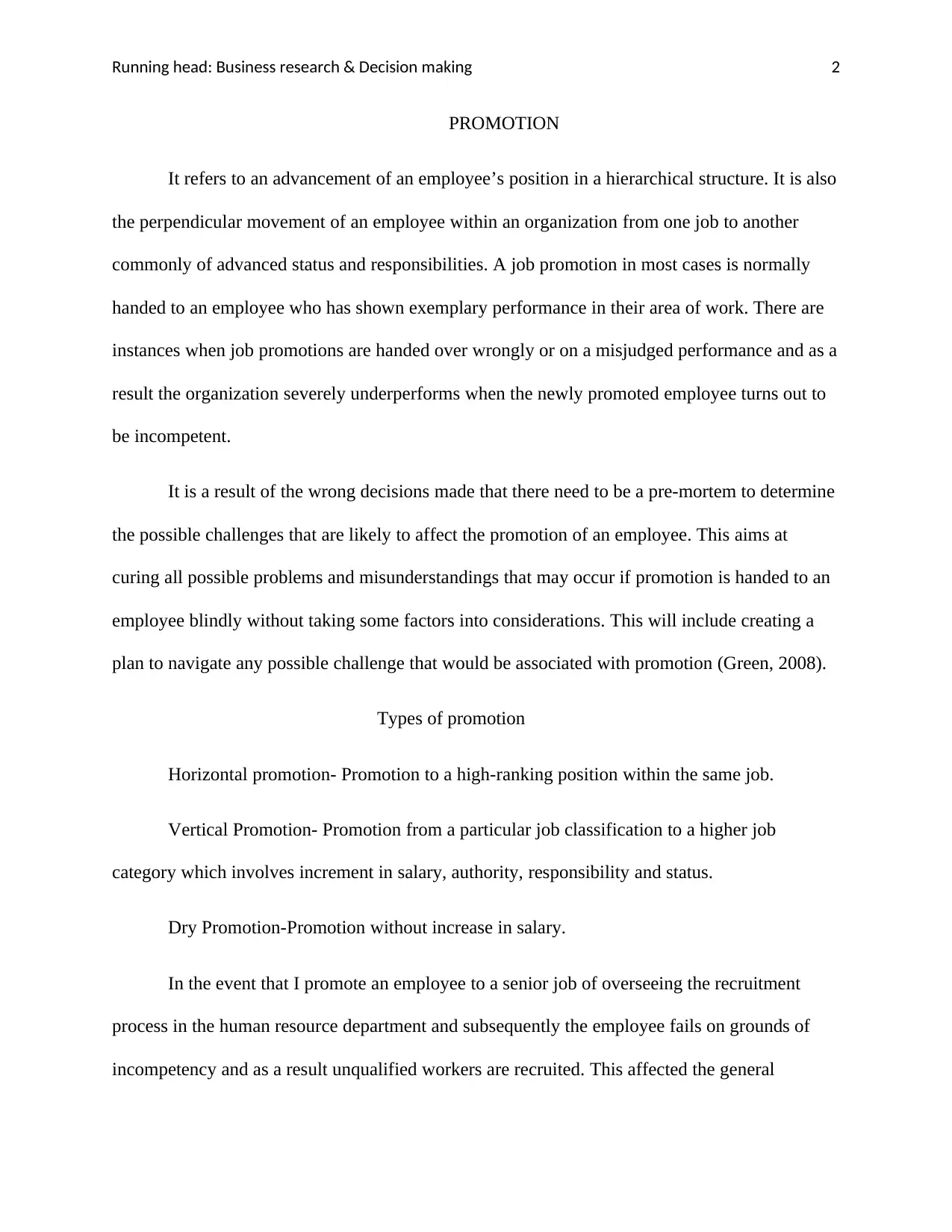
Running head: Business research & Decision making 2
PROMOTION
It refers to an advancement of an employee’s position in a hierarchical structure. It is also
the perpendicular movement of an employee within an organization from one job to another
commonly of advanced status and responsibilities. A job promotion in most cases is normally
handed to an employee who has shown exemplary performance in their area of work. There are
instances when job promotions are handed over wrongly or on a misjudged performance and as a
result the organization severely underperforms when the newly promoted employee turns out to
be incompetent.
It is a result of the wrong decisions made that there need to be a pre-mortem to determine
the possible challenges that are likely to affect the promotion of an employee. This aims at
curing all possible problems and misunderstandings that may occur if promotion is handed to an
employee blindly without taking some factors into considerations. This will include creating a
plan to navigate any possible challenge that would be associated with promotion (Green, 2008).
Types of promotion
Horizontal promotion- Promotion to a high-ranking position within the same job.
Vertical Promotion- Promotion from a particular job classification to a higher job
category which involves increment in salary, authority, responsibility and status.
Dry Promotion-Promotion without increase in salary.
In the event that I promote an employee to a senior job of overseeing the recruitment
process in the human resource department and subsequently the employee fails on grounds of
incompetency and as a result unqualified workers are recruited. This affected the general
PROMOTION
It refers to an advancement of an employee’s position in a hierarchical structure. It is also
the perpendicular movement of an employee within an organization from one job to another
commonly of advanced status and responsibilities. A job promotion in most cases is normally
handed to an employee who has shown exemplary performance in their area of work. There are
instances when job promotions are handed over wrongly or on a misjudged performance and as a
result the organization severely underperforms when the newly promoted employee turns out to
be incompetent.
It is a result of the wrong decisions made that there need to be a pre-mortem to determine
the possible challenges that are likely to affect the promotion of an employee. This aims at
curing all possible problems and misunderstandings that may occur if promotion is handed to an
employee blindly without taking some factors into considerations. This will include creating a
plan to navigate any possible challenge that would be associated with promotion (Green, 2008).
Types of promotion
Horizontal promotion- Promotion to a high-ranking position within the same job.
Vertical Promotion- Promotion from a particular job classification to a higher job
category which involves increment in salary, authority, responsibility and status.
Dry Promotion-Promotion without increase in salary.
In the event that I promote an employee to a senior job of overseeing the recruitment
process in the human resource department and subsequently the employee fails on grounds of
incompetency and as a result unqualified workers are recruited. This affected the general
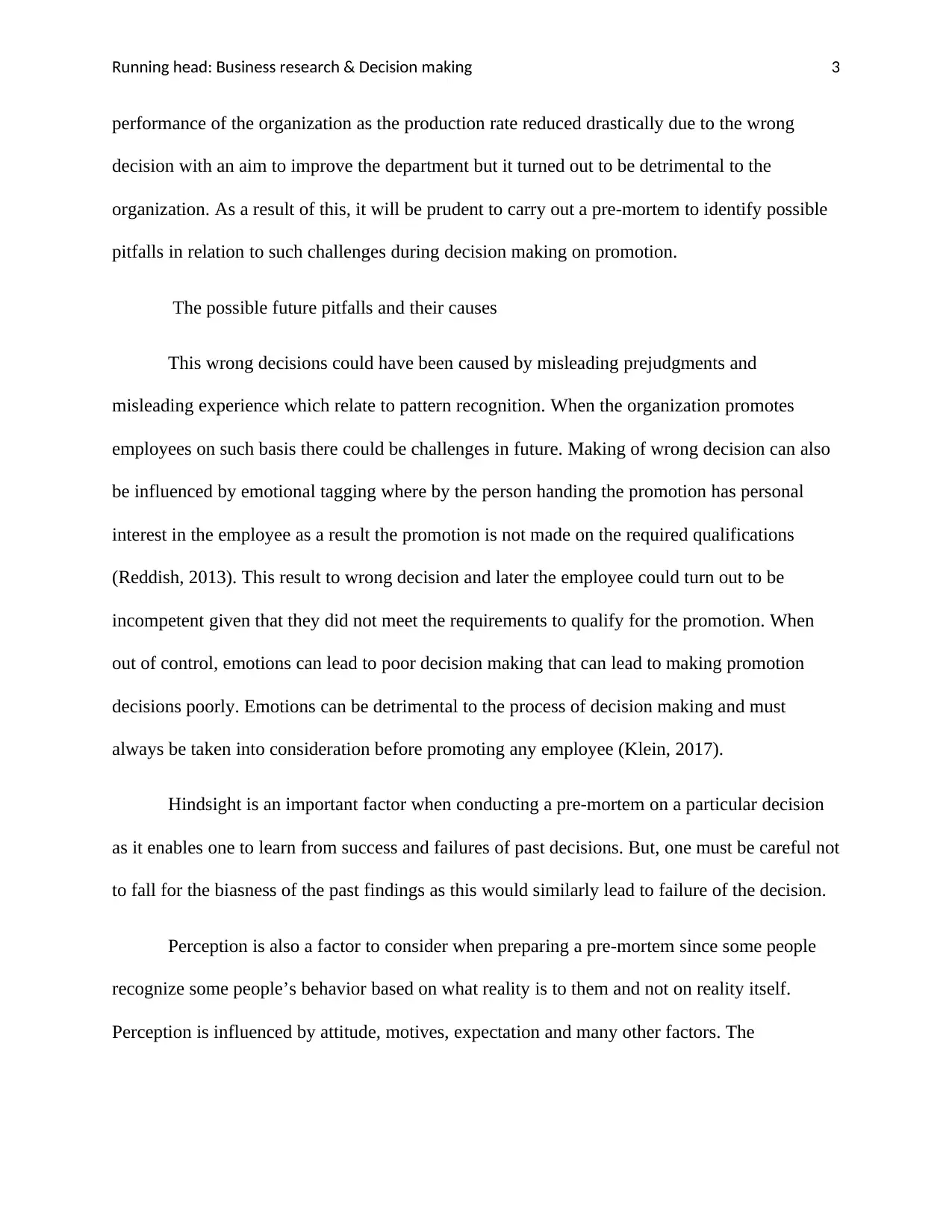
Running head: Business research & Decision making 3
performance of the organization as the production rate reduced drastically due to the wrong
decision with an aim to improve the department but it turned out to be detrimental to the
organization. As a result of this, it will be prudent to carry out a pre-mortem to identify possible
pitfalls in relation to such challenges during decision making on promotion.
The possible future pitfalls and their causes
This wrong decisions could have been caused by misleading prejudgments and
misleading experience which relate to pattern recognition. When the organization promotes
employees on such basis there could be challenges in future. Making of wrong decision can also
be influenced by emotional tagging where by the person handing the promotion has personal
interest in the employee as a result the promotion is not made on the required qualifications
(Reddish, 2013). This result to wrong decision and later the employee could turn out to be
incompetent given that they did not meet the requirements to qualify for the promotion. When
out of control, emotions can lead to poor decision making that can lead to making promotion
decisions poorly. Emotions can be detrimental to the process of decision making and must
always be taken into consideration before promoting any employee (Klein, 2017).
Hindsight is an important factor when conducting a pre-mortem on a particular decision
as it enables one to learn from success and failures of past decisions. But, one must be careful not
to fall for the biasness of the past findings as this would similarly lead to failure of the decision.
Perception is also a factor to consider when preparing a pre-mortem since some people
recognize some people’s behavior based on what reality is to them and not on reality itself.
Perception is influenced by attitude, motives, expectation and many other factors. The
performance of the organization as the production rate reduced drastically due to the wrong
decision with an aim to improve the department but it turned out to be detrimental to the
organization. As a result of this, it will be prudent to carry out a pre-mortem to identify possible
pitfalls in relation to such challenges during decision making on promotion.
The possible future pitfalls and their causes
This wrong decisions could have been caused by misleading prejudgments and
misleading experience which relate to pattern recognition. When the organization promotes
employees on such basis there could be challenges in future. Making of wrong decision can also
be influenced by emotional tagging where by the person handing the promotion has personal
interest in the employee as a result the promotion is not made on the required qualifications
(Reddish, 2013). This result to wrong decision and later the employee could turn out to be
incompetent given that they did not meet the requirements to qualify for the promotion. When
out of control, emotions can lead to poor decision making that can lead to making promotion
decisions poorly. Emotions can be detrimental to the process of decision making and must
always be taken into consideration before promoting any employee (Klein, 2017).
Hindsight is an important factor when conducting a pre-mortem on a particular decision
as it enables one to learn from success and failures of past decisions. But, one must be careful not
to fall for the biasness of the past findings as this would similarly lead to failure of the decision.
Perception is also a factor to consider when preparing a pre-mortem since some people
recognize some people’s behavior based on what reality is to them and not on reality itself.
Perception is influenced by attitude, motives, expectation and many other factors. The
⊘ This is a preview!⊘
Do you want full access?
Subscribe today to unlock all pages.

Trusted by 1+ million students worldwide
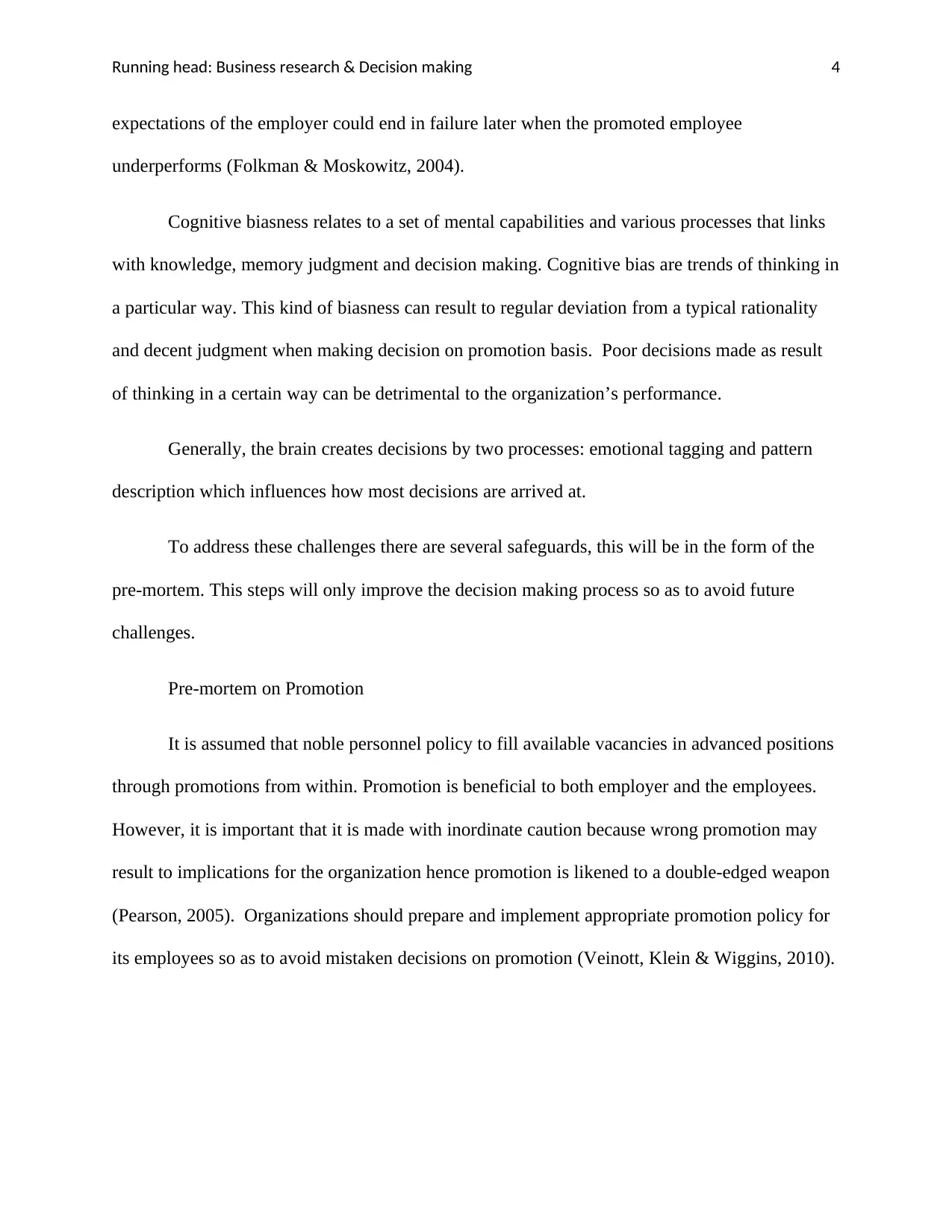
Running head: Business research & Decision making 4
expectations of the employer could end in failure later when the promoted employee
underperforms (Folkman & Moskowitz, 2004).
Cognitive biasness relates to a set of mental capabilities and various processes that links
with knowledge, memory judgment and decision making. Cognitive bias are trends of thinking in
a particular way. This kind of biasness can result to regular deviation from a typical rationality
and decent judgment when making decision on promotion basis. Poor decisions made as result
of thinking in a certain way can be detrimental to the organization’s performance.
Generally, the brain creates decisions by two processes: emotional tagging and pattern
description which influences how most decisions are arrived at.
To address these challenges there are several safeguards, this will be in the form of the
pre-mortem. This steps will only improve the decision making process so as to avoid future
challenges.
Pre-mortem on Promotion
It is assumed that noble personnel policy to fill available vacancies in advanced positions
through promotions from within. Promotion is beneficial to both employer and the employees.
However, it is important that it is made with inordinate caution because wrong promotion may
result to implications for the organization hence promotion is likened to a double-edged weapon
(Pearson, 2005). Organizations should prepare and implement appropriate promotion policy for
its employees so as to avoid mistaken decisions on promotion (Veinott, Klein & Wiggins, 2010).
expectations of the employer could end in failure later when the promoted employee
underperforms (Folkman & Moskowitz, 2004).
Cognitive biasness relates to a set of mental capabilities and various processes that links
with knowledge, memory judgment and decision making. Cognitive bias are trends of thinking in
a particular way. This kind of biasness can result to regular deviation from a typical rationality
and decent judgment when making decision on promotion basis. Poor decisions made as result
of thinking in a certain way can be detrimental to the organization’s performance.
Generally, the brain creates decisions by two processes: emotional tagging and pattern
description which influences how most decisions are arrived at.
To address these challenges there are several safeguards, this will be in the form of the
pre-mortem. This steps will only improve the decision making process so as to avoid future
challenges.
Pre-mortem on Promotion
It is assumed that noble personnel policy to fill available vacancies in advanced positions
through promotions from within. Promotion is beneficial to both employer and the employees.
However, it is important that it is made with inordinate caution because wrong promotion may
result to implications for the organization hence promotion is likened to a double-edged weapon
(Pearson, 2005). Organizations should prepare and implement appropriate promotion policy for
its employees so as to avoid mistaken decisions on promotion (Veinott, Klein & Wiggins, 2010).
Paraphrase This Document
Need a fresh take? Get an instant paraphrase of this document with our AI Paraphraser
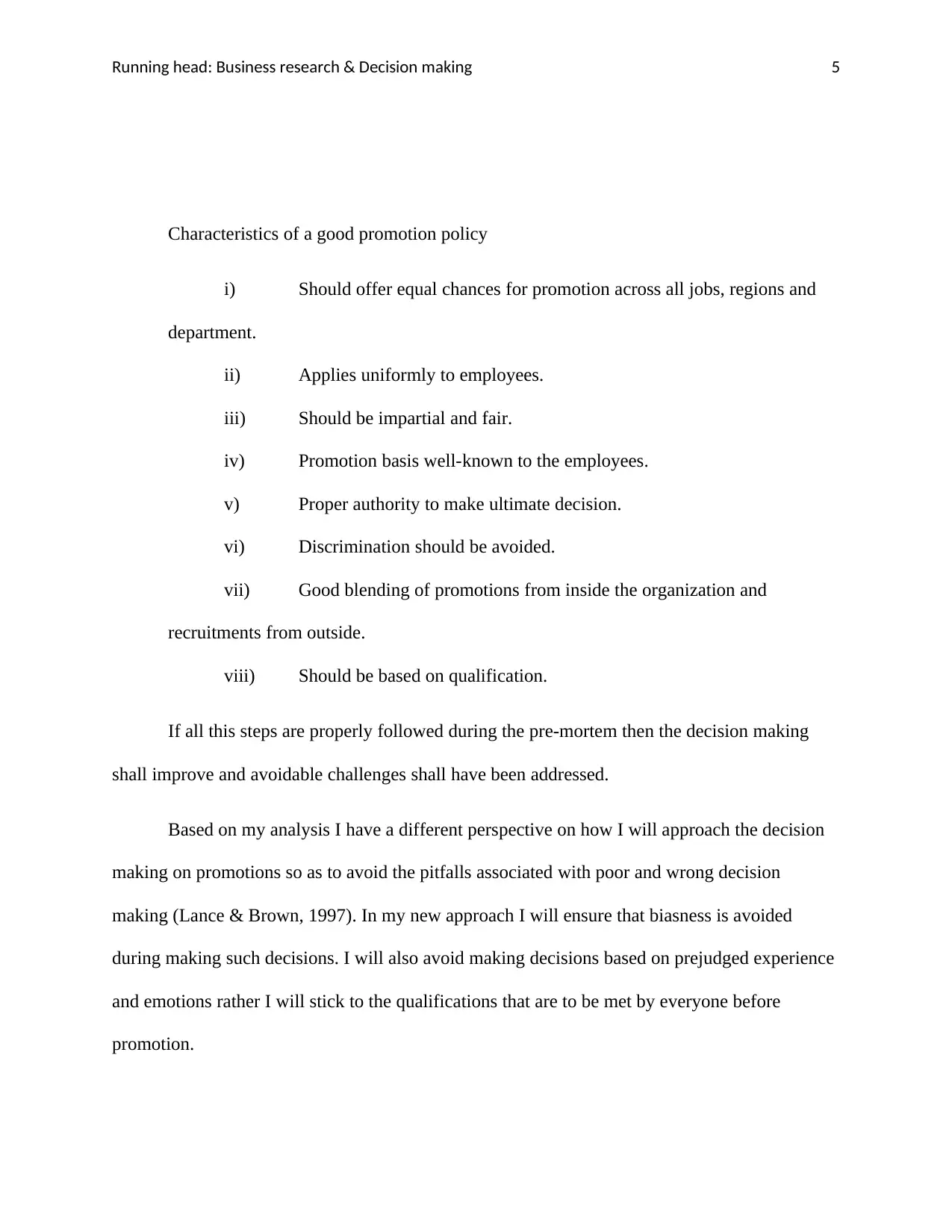
Running head: Business research & Decision making 5
Characteristics of a good promotion policy
i) Should offer equal chances for promotion across all jobs, regions and
department.
ii) Applies uniformly to employees.
iii) Should be impartial and fair.
iv) Promotion basis well-known to the employees.
v) Proper authority to make ultimate decision.
vi) Discrimination should be avoided.
vii) Good blending of promotions from inside the organization and
recruitments from outside.
viii) Should be based on qualification.
If all this steps are properly followed during the pre-mortem then the decision making
shall improve and avoidable challenges shall have been addressed.
Based on my analysis I have a different perspective on how I will approach the decision
making on promotions so as to avoid the pitfalls associated with poor and wrong decision
making (Lance & Brown, 1997). In my new approach I will ensure that biasness is avoided
during making such decisions. I will also avoid making decisions based on prejudged experience
and emotions rather I will stick to the qualifications that are to be met by everyone before
promotion.
Characteristics of a good promotion policy
i) Should offer equal chances for promotion across all jobs, regions and
department.
ii) Applies uniformly to employees.
iii) Should be impartial and fair.
iv) Promotion basis well-known to the employees.
v) Proper authority to make ultimate decision.
vi) Discrimination should be avoided.
vii) Good blending of promotions from inside the organization and
recruitments from outside.
viii) Should be based on qualification.
If all this steps are properly followed during the pre-mortem then the decision making
shall improve and avoidable challenges shall have been addressed.
Based on my analysis I have a different perspective on how I will approach the decision
making on promotions so as to avoid the pitfalls associated with poor and wrong decision
making (Lance & Brown, 1997). In my new approach I will ensure that biasness is avoided
during making such decisions. I will also avoid making decisions based on prejudged experience
and emotions rather I will stick to the qualifications that are to be met by everyone before
promotion.
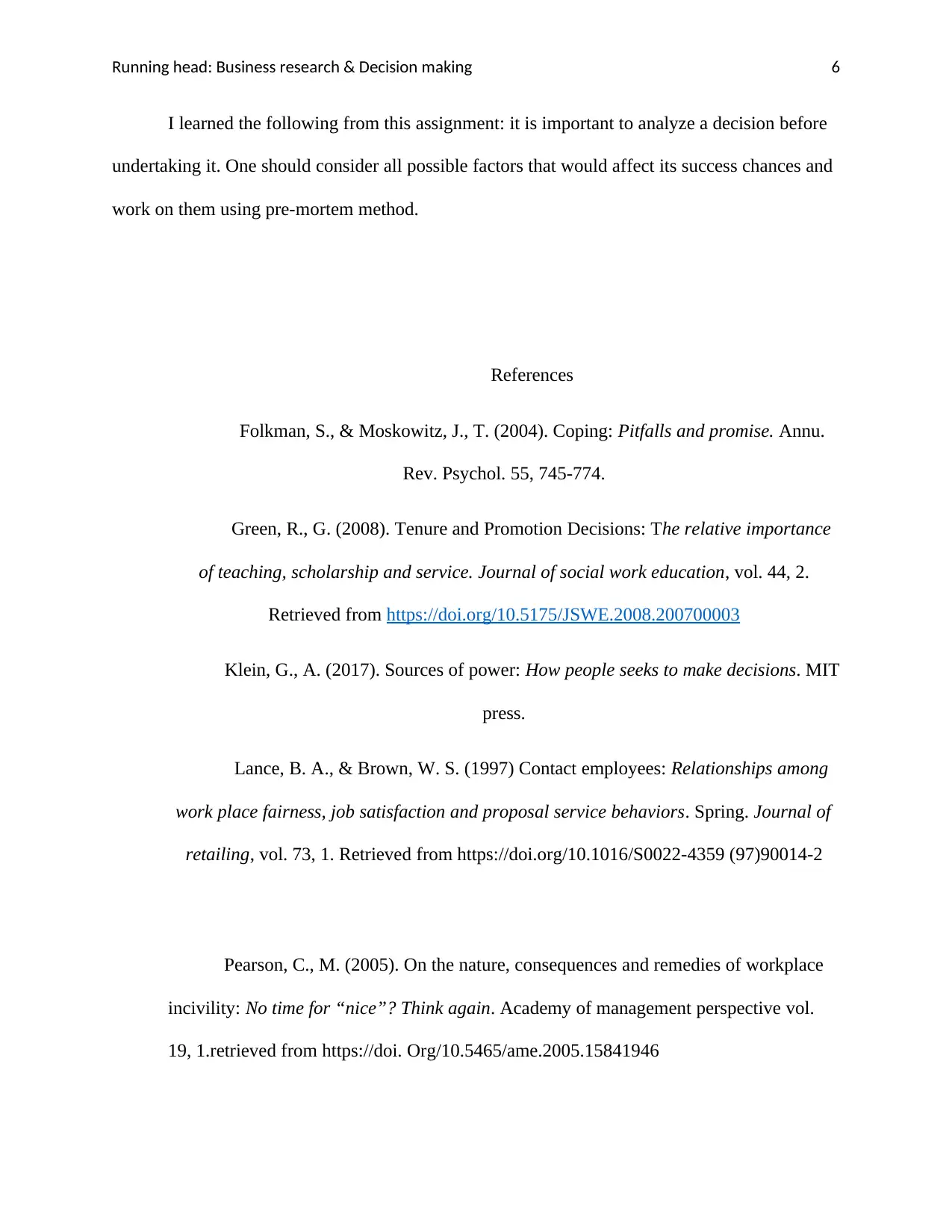
Running head: Business research & Decision making 6
I learned the following from this assignment: it is important to analyze a decision before
undertaking it. One should consider all possible factors that would affect its success chances and
work on them using pre-mortem method.
References
Folkman, S., & Moskowitz, J., T. (2004). Coping: Pitfalls and promise. Annu.
Rev. Psychol. 55, 745-774.
Green, R., G. (2008). Tenure and Promotion Decisions: The relative importance
of teaching, scholarship and service. Journal of social work education, vol. 44, 2.
Retrieved from https://doi.org/10.5175/JSWE.2008.200700003
Klein, G., A. (2017). Sources of power: How people seeks to make decisions. MIT
press.
Lance, B. A., & Brown, W. S. (1997) Contact employees: Relationships among
work place fairness, job satisfaction and proposal service behaviors. Spring. Journal of
retailing, vol. 73, 1. Retrieved from https://doi.org/10.1016/S0022-4359 (97)90014-2
Pearson, C., M. (2005). On the nature, consequences and remedies of workplace
incivility: No time for “nice”? Think again. Academy of management perspective vol.
19, 1.retrieved from https://doi. Org/10.5465/ame.2005.15841946
I learned the following from this assignment: it is important to analyze a decision before
undertaking it. One should consider all possible factors that would affect its success chances and
work on them using pre-mortem method.
References
Folkman, S., & Moskowitz, J., T. (2004). Coping: Pitfalls and promise. Annu.
Rev. Psychol. 55, 745-774.
Green, R., G. (2008). Tenure and Promotion Decisions: The relative importance
of teaching, scholarship and service. Journal of social work education, vol. 44, 2.
Retrieved from https://doi.org/10.5175/JSWE.2008.200700003
Klein, G., A. (2017). Sources of power: How people seeks to make decisions. MIT
press.
Lance, B. A., & Brown, W. S. (1997) Contact employees: Relationships among
work place fairness, job satisfaction and proposal service behaviors. Spring. Journal of
retailing, vol. 73, 1. Retrieved from https://doi.org/10.1016/S0022-4359 (97)90014-2
Pearson, C., M. (2005). On the nature, consequences and remedies of workplace
incivility: No time for “nice”? Think again. Academy of management perspective vol.
19, 1.retrieved from https://doi. Org/10.5465/ame.2005.15841946
⊘ This is a preview!⊘
Do you want full access?
Subscribe today to unlock all pages.

Trusted by 1+ million students worldwide

Running head: Business research & Decision making 7
Reddish, D., A. (2013). The mind within the brain: How we make decisions and
how those decisions go. Oxford press, United States.
Veinott, B., Klein, G., A., & Wiggins, S. (2010). Evaluating the effectiveness of
the premoterm technique on plan confidence. Proceedings of the 7th international
ISCRAM conference.
Reddish, D., A. (2013). The mind within the brain: How we make decisions and
how those decisions go. Oxford press, United States.
Veinott, B., Klein, G., A., & Wiggins, S. (2010). Evaluating the effectiveness of
the premoterm technique on plan confidence. Proceedings of the 7th international
ISCRAM conference.
1 out of 7
Related Documents
Your All-in-One AI-Powered Toolkit for Academic Success.
+13062052269
info@desklib.com
Available 24*7 on WhatsApp / Email
![[object Object]](/_next/static/media/star-bottom.7253800d.svg)
Unlock your academic potential
Copyright © 2020–2025 A2Z Services. All Rights Reserved. Developed and managed by ZUCOL.





